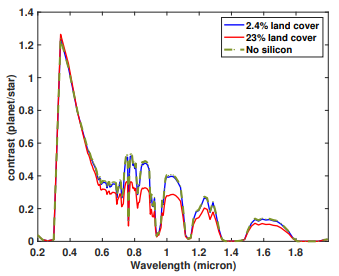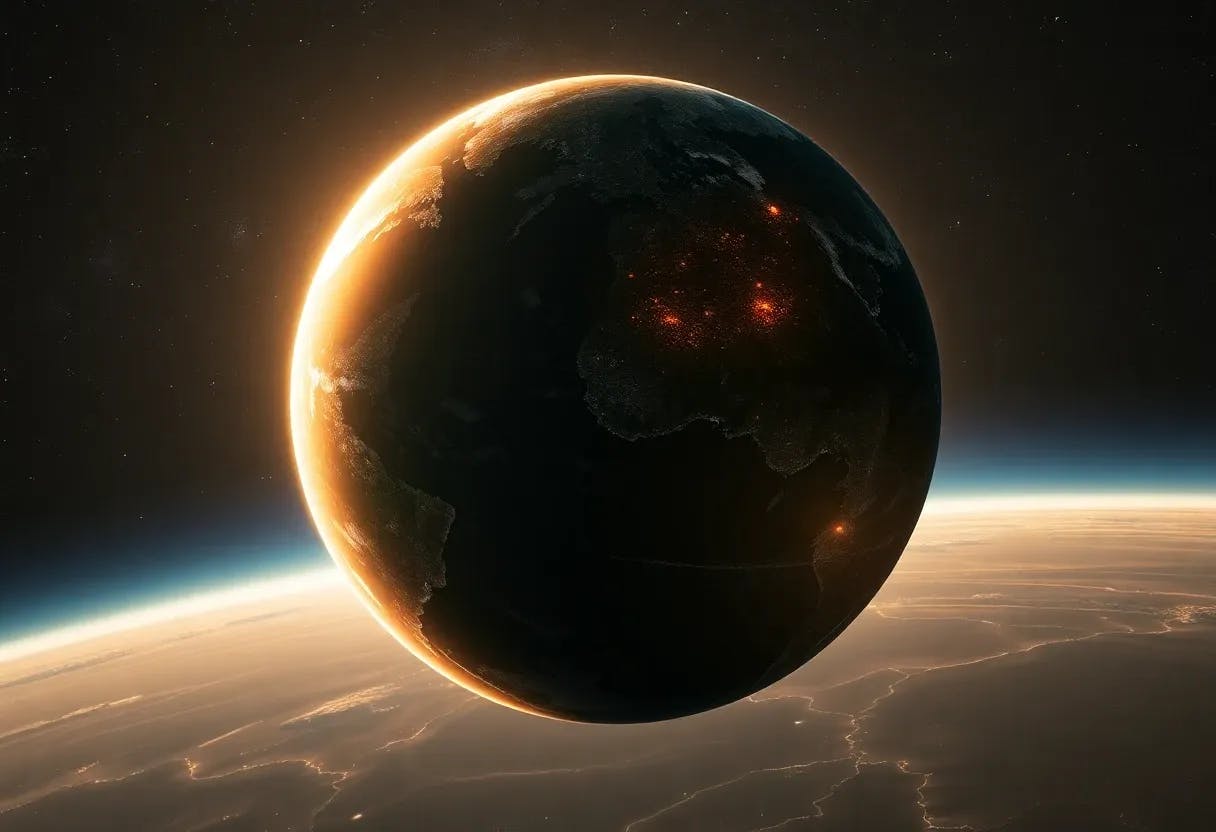Table of Links
ABSTRACT
1. INTRODUCTION
2. METHODS
3. PHOTOVOLTAIC REQUIREMENTS FOR EARTH
4. DETECTABILITY REQUIREMENTS FOR PHOTOVOLTAICS
5. DISCUSSION
- CONCLUSION, ACKNOWLEDGMENTS AND REFERENCES
DISCUSSION
The results from the previous section seem to indicate that even ambitious deployment of solar panels (constructed with silicon and hosting anti-reflective coatings) covering a significant land area of an Earth-like exoplanet may not be enough to be detectable with a 8 m HWO-like telescope. These calculations presumed a fixed-present day efficiency for solar panels, so any technological improvements in efficiency would only decrease the required land coverage, and consequently decrease detectability. Lingam & Loeb (2017) conjectured that tidally locked planets around M-dwarfs might be a suitable place to start looking for photovoltaic cells.
Unfortunately, due to the close proximity of planets in the habitable zone around Mdwarfs – which poses issue for spatially resolving the planet – currently there is no technological pathway to directly observing these types of planets. In the case that this setup would be possible though, the detectability of the silicon UV edge on planets around M-dwarfs would be further diminished, since the stellar emission in the relevant range (0.34 − 0.52 µm) is significantly lower.
Note that we have performed all of the SNR calculations based on an orbital phase angle of 270◦ with edge-on orbital configuration (i.e., inclination = 90◦ ). Additional calculations varying the phase angle, varying the inclination angle, and so forth are needed to fully assess the potential detectability. Furthermore, we have not explored the extent of the effect of varying mirror size on the SNR, or a different stellar host spectral type (like a K-dwarf star).

Berdyugina & Kuhn (2019) generated composite maps of orbiting photovoltaic power sources if they were situated around a planet like Proxima Centauri b. Specific simulations and the corresponding SNR estimates relevant for HWO from such orbiting structures needs to be undertaken. These additional considerations are left for future work.
As Earth remains the only example of an inhabited planet with a technosphere, future trajectories of Earth can provide insight into the constraints that might also apply to extraterrestrial technospheres. It is worth reiterating that only 3% land coverage by solar panels would be needed to support a population of 10 billion people at a high standard of living, and the toy logistic curve shown in Figure 2 indicates that even a population of 30 billion people at a high standard of living would require far less energy than the power output of the 23% land coverage scenario used in these detectability calculations.
These estimates not only do not account for increased efficiency due to technological innovations, but they also do not account for other sources of energy. Hence, the actual solar requirements for Earth would likely be much reduced, especially in case controlled nuclear fusion becomes viable. For Earth, these results suggest the possibility of a future in which the energy needs of even a larger-than-predicted population could be fully met with known technology.
If Earth is taken as an example in the search for technosignatures, then this raises the question: Is the large-scale deployment of solar panels on a planetary surface ever needed? Any actual large-scale deployment would certainly raise numerous issues regarding the feasibility of such a deployment or the logistical challenges in global distribution of energy, but a more fundamental unknown is whether a technological civilization would ever require such large energy demands to justify a scenario such as 23% land coverage or greater.
Several of the projections shown in Figure 2 reach a time at which dissipation from energy use exceeds the threshold for contributing significant direct heating to Earth’s climate (∼ 3 × 1023 J), which occurs in the year 2265 for the 2.6% yr−1 growth rate scenario and 2338 for the 2% yr−1 growth rate scenario. Yet, it is not evident that such vast energy requirements will ever be necessary on Earth: the energy requirements for the global human population to afford a high standard of living fall several orders of magnitude below the direct heating threshold.
The motivation to prevent direct heating of the atmosphere may serve as an additional deterrent to avoid such scenarios, and further suggests that only modest-scale deployment of solar panels would ever be needed to achieve sustainable development goals on Earth.Speculating even further shows that these scenario projections will reach the limit of a Kardashev Type I civilization (Kardashev 1964), which is a civilization that uses all available energy on its planet (i.e., all starlight incident at the top of the atmosphere). This Type I threshold (∼ 5 × 1024 J) occurs in the year 2377 for the 2.6% yr−1 growth rate scenario and 2482 for the 2% yr−1 growth rate scenario.
The equivalent land area required to meet such energy demands with solar power exceeds 100% in these cases, which indicate that other sources of power—possibly including space-based solar power—would be required in these scenarios. Such speculative scenarios suggest images of “Dyson spheres/swarms” (e.g., Dyson 1960; Wright 2020) of solar collectors that expand a civilization’s ability to capture the energy output of its host star. Kardashev (1964) even imagined a Type II civilization as one that utilizes the entirety of its host star’s output; however, such speculations are based primarily on the assumption of a fixed growth rate in world energy use.
But such vast energy reserves would be unnecessary even under cases of substantial population growth, especially if fusion and other renewable sources are available to supplement solar energy. The concept of a Type I or Type II civilization then becomes an exercise in imagining the possible uses that a civilization would have for such vast energy reserves. Even activities such as large-scale physics experiments and (relativistic) interstellar space travel (cf. Lingam & Loeb 2021, Chapter 10) might not be enough to explain the need for a civilization to harness a significant fraction of its entire planetary or stellar output.
In contrast, if human civilization can meet its own energy demands with only a modest deployment of solar panels, then this expectation might also suggest that concepts like Dyson spheres would be rendered unnecessary in other technospheres. These results also have implications for the problem known as the Fermi paradox (Webb 2015; Cirkovi´c 2018 ´ ; Forgan 2019) or Great Silence (Brin 1983): if extraterrestrial expansion through the galaxy is relatively easy, then where are they? In the context of limits to growth, the recognition that human civilization could reach a sustainable equilibrium in its population and energy use that falls well below the Type I threshold suggests that extraterrestrial civilizations may not be compelled to expand for reasons of subsistence.
This conclusion mirrors the “sustainability solution” to the Fermi paradox (e.g., Haqq-Misra & Baum 2009; Mullan & Haqq-Misra 2019), which suggests that any extant extraterrestrial civilizations only expand proportionally with their planet’s carrying capacity. Any civilization that is able to achieve sustainable population levels with high standard of living may also settle on a limit on any need to expand, which may likewise constrain the magnitude of any potential technosignatures generated by such a civilization.
Underlying this discussion are two competing philosophical positions regarding the tendency of life to expand. The first position assumes that (a) life will evolve to utilize the maximum energy available in its environment, while the second assumes that (b) life will evolve to utilize as much energy as needed in its environment to reach an optimal level of existence. To the extent that the environment will always impose thermodynamic limits, the second option (b) may probably be favored by life. But does life tend to expand up to such thermodynamic limits if unopposed, or will life tend to optimize its consumption of resources rather than maximize them? Such interdisciplinary questions highlight the intersection of technosignature science with concepts from ecology (e.g., Meurer et al. 2024), and further scrutiny of the proposed general tendency of life to expand may be useful for thinking about and enivisioning the particular tendencies for technospheres to expand.
CONCLUSION, ACKNOWLEDGMENTS AND REFERENCES
We analyzed the detectability of silicon-based solar panels (with anti-reflective coatings) as a signature of extraterrestrial technology. Assuming a 8-meter HWO-like telescope, focusing on the reflection edge in the UV-VIS, and considering varying land coverage of solar panels on an Earth-like exoplanet that match the present and projected energy needs, we estimate that several hundreds of hours of observation time is needed to reach a SNR of ∼ 5 for a high land coverage of ∼ 23%. We subsequently assessed the need for the deployment of such large-scale solar panels, taking into consideration various projected growth rates of future energy consumption.
We find that, even with significant population growth, the energy needs of human civilization would be several orders of magnitude below the energy threshold for a Kardashev Type I civilization, or a Dyson sphere/swarm which harnesses the energy of a star. This line of inquiry reexamines the utility of such concepts, and potentially addresses one crucial aspect of the Fermi paradox: we have not discovered any large scale engineering yet, conceivably because advanced technologies may not need them.
ACKNOWLEDGMENTS
J.H.M., M.L., and R.K.K. gratefully acknowledge support from the NASA Exobiology program under grant 80NSSC22K1009. The authors also acknowledge support from the Goddard Space Flight Center (GSFC) Sellers Exoplanet Environments Collaboration (SEEC), which is supported by the NASA Planetary Science Division’s Research Program. Any opinions, findings, and conclusions or recommendations expressed in this material are those of the authors and do not necessarily reflect the views of their employers or NASA.
REFERENCES
Arnold, L., Gillet, S., Lardi`ere, O., Riaud, P., & Schneider, J. 2002, Astronomy & Astrophysics, 392, 231
Arto, I., Capell´an-P´erez, I., Lago, R., Bueno, G., & Bermejo, R. 2016, Energy for Sustainable Development, 33, 1
Bazilian, M., Onyeji, I., Liebreich, M., et al. 2013, Renewable Energy, 53, 329
Beatty, T. G. 2022, Monthly Notices of the Royal Astronomical Society, 513, 2652
Berdyugina, S., & Kuhn, J. 2019, The Astronomical Journal, 158, 246
Brin, G. D. 1983, Quarterly Journal of the Royal Astronomical Society, Vol. 24, NO. 3, P. 283-309, 1983, 24, 283
Campbell, P., & Green, M. A. 1987, Journal of Applied Physics, 62, 243, doi: 10.1063/1.339189
Cirkovi´c, M. M. 2018, The great silence: Science and ´ philosophy of Fermi’s paradox (Oxford University Press)
Dyson, F. J. 1960, Science, 131, 1667
Forgan, D. H. 2019, Solving Fermi’s paradox, Vol. 10 (Cambridge University Press)
Haqq-Misra, J., & Baum, S. 2009, Journal of the British Interplanetary Society, 62, 47
Haqq-Misra, J., Fauchez, T. J., Schwieterman, E. W., & Kopparapu, R. 2022a, The Astrophysical Journal Letters, 929, L28
Haqq-Misra, J., Kopparapu, R., Fauchez, T. J., et al. 2022b, The Planetary Science Journal, 3, 60
Haqq-Misra, J., Schwieterman, E. W., Socas-Navarro, H., et al. 2022c, Acta Astronautica, 198, 194
Jackson, R. B., Ahlstr¨om, A., Hugelius, G., et al. 2022, Ecosphere, 13, e3978
Juanola-Parramon, R., Zimmerman, N. T., Pueyo, L., et al. 2022, Journal of Astronomical Telescopes, Instruments, and Systems, 8, 034001, doi: 10.1117/1.JATIS.8.3.034001
Kardashev, N. S. 1964, Soviet Ast., 8, 217 Kim, M. S., Lee, J. H., & Kwak, M. K. 2020, International Journal of Precision Engineering and Manufacturing, 21, 1389
Kokaly, R. F., Clark, R. N., Swayze, G. A., et al. 2017, USGS Spectral Library Version 7, Tech. Rep. 1035, U.S. Geological Survey, doi: 10.3133/ds1035
Kopparapu, R., Arney, G., Haqq-Misra, J., Lustig-Yaeger, J., & Villanueva, G. 2021, The Astrophysical Journal, 908, 164
Lin, H. W., Gonzalez Abad, G., & Loeb, A. 2014, ApJL, 792, L7, doi: 10.1088/2041-8205/792/1/L7
Lingam, M., & Loeb, A. 2017, MNRAS, 470, L82, doi: 10.1093/mnrasl/slx084 —. 2019, Astrobiology, 19, 28, doi: 10.1089/ast.2018.1936 —. 2021, Life in the Cosmos: From Biosignatures to Technosignatures (Cambridge: Harvard University Press)
Macdonald, D. H., Cuevas, A., Kerr, M. J., et al. 2004, Solar Energy, 76, 277, doi: 10.1016/j.solener.2003.08.019
Meurer, J. C., Haqq-Misra, J., & de Souza Mendon¸ca, M. 2024, International Journal of Astrobiology, 23, e3
Miller, L. M., & Keith, D. W. 2018, Environmental Research Letters, 13, 104008
Millward-Hopkins, J., Steinberger, J. K., Rao, N. D., & Oswald, Y. 2020, Global Environmental Change, 65, 102168
Mullan, B., & Haqq-Misra, J. 2019, Futures, 106, 4 NASA Technosignatures Workshop Participants. 2018, arXiv e-prints, arXiv:1812.08681, doi: 10.48550/arXiv.1812.08681 O’Malley-James, J. T., & Kaltenegger, L. 2018, Astrobiology, 18, 1123 Owen, T. 1980, in Strategies for the Search for Life in the Universe (Springer), 177–185
Pieters, C. M., & Hiroi, T. 2004, in Lunar and Planetary Science Conference, ed. S. Mackwell & E. Stansbery, Lunar and Planetary Science Conference, 1720
Raut, H. K., Ganesh, V. A., Nair, A. S., & Ramakrishna, S. 2011, Energy & Environmental Science, 4, 3779 R¨uhle, S. 2016, Solar Energy, 130, 139, doi: 10.1016/j.solener.2016.02.015
Sagan, C., Thompson, W. R., Carlson, R., Gurnett, D., & Hord, C. 1993, Nature, 365, 715
Sarkın, A. S., Ekren, N., & Sa˘glam, S¸. 2020, Solar Energy, 199, 63, doi: 10.1016/j.solener.2020.01.084
Schwieterman, E. W., Kiang, N. Y., Parenteau, M. N., et al. 2018, Astrobiology, 18, 663, doi: 10.1089/ast.2017.1729
Seager, S., Petkowski, J. J., Huang, J., et al. 2023, Scientific Reports, 13, 13576
Seager, S., Turner, E. L., Schafer, J., & Ford, E. B. 2005, Astrobiology, 5, 372, doi: 10.1089/ast.2005.5.372
Socas-Navarro, H., Haqq-Misra, J., Wright, J. T., et al. 2021, Acta Astronaut., 182, 446, doi: 10.1016/j.actaastro.2021.02.029
Tarter, J. C. 2007, Highlights of Astronomy, 14, 14, doi: 10.1017/S1743921307009829
Turnbull, M. C., Traub, W. A., Jucks, K. W., et al. 2006, The Astrophysical Journal, 644, 551
Varga, G. 2020, Environment international, 139, 105712
Villanueva, G. L., Liuzzi, G., Faggi, S., et al. 2022, Fundamentals of the Planetary Spectrum Generator (Greenbelt, Maryland: NASA Goddard Space Flight Center)
Villanueva, G. L., Smith, M. D., Protopapa, S., Faggi, S., & Mandell, A. M. 2018, JQSRT, 217, 86, doi: 10.1016/j.jqsrt.2018.05.023
Vogel, J., Steinberger, J. K., O’Neill, D. W., Lamb, W. F., & Krishnakumar, J. 2021, Global Environmental Change, 69, 102287
Von Hoerner, S. J. 1975, Journal of the British Interplanetary Society, 28, 691 Webb, S. 2015, If the universe is teeming with aliens… where is everybody?: seventy-five solutions to the fermi paradox and the problem of extraterrestrial life (Springer)
Woolf, N. J., Smith, P. S., Traub, W. A., & Jucks, K. W. 2002, The Astrophysical Journal, 574, 430
Wright, J. T. 2020, Serbian Astronomical Journal, 1
Zhao, J., & Green, M. A. 1991, IEEE Transactions on Electron Devices, 38, 1925, doi: 10.1109/16.119035
:::info
Authors:
- Ravi Kopparapu
- Vincent Kofman
- Jacob Haqq-Misra
- Vivaswan Kopparapu
- Manasvi Lingam
:::
:::info
This paper is available on arxiv under CC BY 4.0 DEED license.
:::









